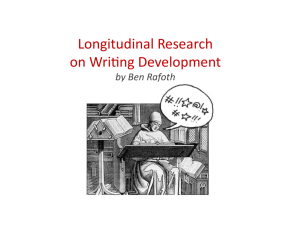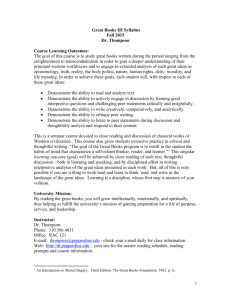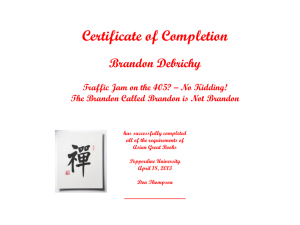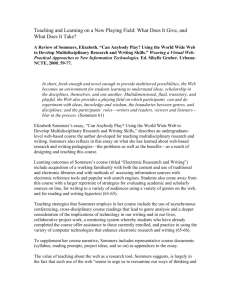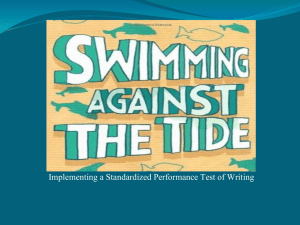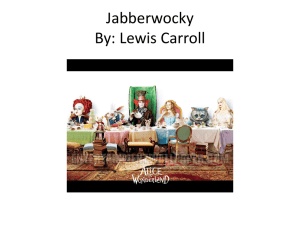Longitudinal Research on Writing Development
advertisement
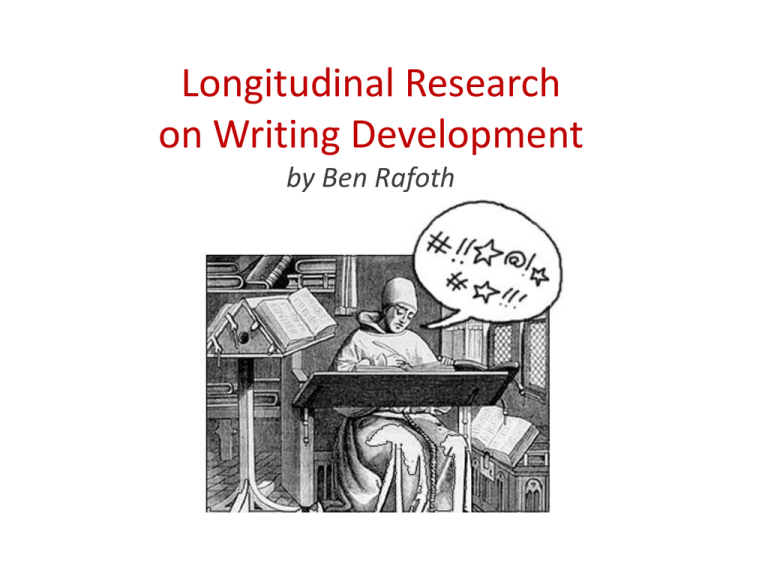
Longitudinal Research on Writing Development by Ben Rafoth Longitudinal Studies of Writing Development • CUNY -- Marilyn Sternglass's (1997)Time to Know Them: A Longitudinal Study of Writing and Learning at the College Level. • Pepperdine -- Lee Ann Carroll's (2002) Rehearsing New Roles: How College Students Develop as Writers. • Amherst -- Anne Herrington and Marcia Curtis's (2003) Persons in Process: Four Stories of Writing and Personal Development in College. Also Curtis and Herrington, "Writing Development in the College Years: By Whose Definition?" CCC 55.1. • Harvard -- Nancy Sommers and Laura Saltz's (2004) "The Novice as Expert: Writing the Freshman Year.“ CCC 56.1 • UWashington -- Ann Beaufort's (2004) Developmental Gains of a History Major: A Case for Building a Theory of Disciplinary Writing Expertise. Who did they study? • • • • • CUNY 53/9 students for 6 years Pepperdine 20 students for 4 years Amherst 4 students for 4 years Harvard 400/65 students UWashington 1 student for 4 years + 2 on job Findings from longitudinal studies relevant to writing center work 1. Progress is uneven (UWashington; CUNY; Pepperdine; UMass; Harvard) 2. Credits not conducive to tracking progress (Harvard); FYC seems arbitrary (CUNY; Pepperdine; UWashington) 3. How and what of writing are inseparable (Pepperdine; Harvard – freshman repeat ideas) 4. Errors persist until commitment overtakes them (Pepperdine; UMass) 5. Lots of tutoring in residence halls (Pepperdine); Tutoring is about relationships (Harvard) 6. Nontraditional students are persistent (CUNY) 7. Students can talk about it before they can do it (Harvard) City University of New York • Study began with 53 students in her first-year writing course; she followed them for 6 years – 21 African American, 26 Latino, 4 Asian, 2 White – 9 followed very closely, including several basic writers • By 1996…… – – – – 17 graduated 10 transferred 18 dropped out 8 were still studying • Marilyn Sternglass Key findings from CUNY study • Students can and do learn critical literacy, but it’s far from a smooth trajectory. • Students’ learning outcomes don’t map well to courses and credits. How CUNY study looked at development of students’ thinking • The Five Stages of Knowing* – Silence: total dependence on whims of external authority – Received Knowledge: receive and reproduce knowledge – Subjective Knowledge: truth and knowledge are conceived of as personal, private, and intuited – Procedural Knowledge: rely on objective procedures for obtaining and communicating knowledge – Constructed Knowledge: view all knowledge as contextual; value subjective and objective strategies *Women’s Ways of Knowing by Mary Belenky, Blythe Clinchy, Nancy Goldberger, Jill Tarule (1986) Pepperdine Study • 20 students, 4 years, 1994-1998 • Students assembled paper and digital portfolios of their work • Lee Ann Carroll (2002) Notions of Writing Development in the Pepperdine Study • Development measured against Scardamalia’s (1981) theory of cognitive development: “taking progressively more variables into account during a single act of judgment” – Genre and discourse conventions – Locating and interpreting relevant sources – Applying concepts from the discipline – Developing evidence acceptable in the discipline – Organizing all this into a single coherent text ALL 20 students became more adept at this by senior year Writing in General Education Courses • Even mediocre papers can represent significant learning to students • Students perceive first year writing criteria as too subjective • Students remained novices in the genres and complex literacy tasks of the various fields in their gen ed courses • Great Books sequence – 4 semesters, similar literacy tasks (reading and thesis/support essays) – 16 students, full time professors – Students made solid gains in their ability to write this kind of essay U. Massachusetts Amherst Study • 4 students, 4 years, 1989-1993 • 3 of these were basic writers • Anne Herrington and Marcia Curtis Findings: the Personal and the Public • Experienced growth with steady focus on a single or small set of related topics – writing as self-fashioning. • Basic writing surface errors persisted through senior year, particularly when the content/form was difficult or new. • Definite though not steady progress in academic writing skills – Learned specialized diction, organization and subject/audience relationships – Improved ability to work with the theories, concepts and professional texts of their field – Increased ability to interpret and incorporate outside texts Harvard Study of Undergraduate Writing • 400 writers, 4 years, 2001-2004 – all academic writing – annual surveys – In-depth interviews with 65 students • Nancy Sommers Key finding from the Harvard Study: Development is not linear • “The movement from first year writing to senior, from novice to expert, if it happens at all, looks more like one step forward, two steps back, . . . . First Year Writers • Learn to write by first repeating the ideas they encounter in the sources they read and the teachers they admire. UWashington Case Study • 1 student ,“Tim,” 4 years + two years later at work • History and Engineering double major, then engineering job • Anne Beaufort Tim as a History major • Rhetorical: By the end of year three, had not been able to write to and for the discourse community of historians, although he was aware verbally of some differences. He wrote for himself and for his professor. • Subject area: He had picked up some of the central historical concepts about periods. He tended to write about religious themes, which he knew well, but struggled with appropriate interpretation of primary sources • Genre: Tim “peaked” in his sophomore year with a good paper that had a “thesis, detailed support, logical connection of ideas.” It wasn’t a breakthrough because his junior-year papers not as strong. • Writing Process: junior year – brief planning, 1 page an hour, some final sentence-level editing. Tim as an Engineering major • Had to re-learn both genre and rhetorical features: – – – – – standard formats; bullets and subheadings, not paragraphs and dense pages brevity “convince with data” rather than “persuade” reason by eliminating all possible bad solutions and arriving at the best one drawing pictures was often better than writing to communicate ideas • He learned sentence-level genre features first (passives, no quotations) • School cannot replace a real-world work context. – The peer review in school that seemed annoying was necessary, desirable, standard practice at work. – The logbook he kept in school of his thinking, ideas, and work became a substantial and useful tool in the workplace; he took considerable time with it and shared it with others. – There were legal and safety issues to consider at work, which really drove the rhetorical situation home. Review of findings from the five longitudinal studies 1. Progress is uneven (Beaufort; Sternglass; Carroll; Herrington & Curtis; Sommers) 2. Credits not conducive to tracking progress (Sommers); FYC seems arbitrary (Sternglass; Carroll; Beaufort) 3. How and what of writing are inseparable (Carroll; Sommers – freshman repeat ideas) 4. Errors persist until commitment overtakes them (Carroll; Herrington & Curtis) 5. Lots of tutoring in residence halls (Carroll); Tutoring is about relationships (Sommers) 6. Nontraditional students are persistent (Sternglass) 7. Students can talk about it before they can do it (Sommers) Bringing it all Together • Students do make progress but development is slow and nonlinear. Pre-post- test, anyone? • If the how and what of writing are inseparable, how can generalist tutors help? • If the courses-and-credits structure is so problematic, can writing centers be agents of change to this system?
